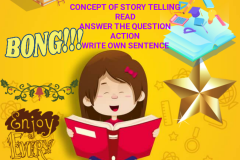Why Jolly Phonics is Superior to Traditional Reading.
We have seen numerous studies and have learned through experience: Jolly Phonics is superior to any traditional method of teaching children how to read. The best part: it is so much fun that it doesnâ??t seem like work to them. It is more like playing a game than like going to school.
To understand what makes Jolly Phonics superior to traditional learning, it is important to understand the fallacies and faults of traditional learning.
Whatâ??s Wrong with Traditional Learning?
The main problem with traditional learning is that the English language doesnâ??t set up very well for it. When English was created, it was mainly a combination of four different languages: Old Norse, Germanic Anglo-Saxon, Norman French and the churchâ??s Latin. Between 1350 and 1700, pronunciations of many words changed in what was known as the â??Great Vowel Shift.â?? In addition, scribes who were paid by the letter added letters to words so they could get paid more.
Soon, the enlightenment would bring science and technology, which added more words. These often came from Greek and Latin, but also from Hindi and Spanish. In Australia, words like â??yakkaâ?? were taken from the Australian indigenous language Yagara. Today, new words are constantly added to the language, based on cultural phenomena and advances in all scholarly fields such as psychology, philosophy, mathematics, science and physics.
When English added words from another language, they usually kept that languageâ??s spelling patterns. That means that, for example, the letter combination â??châ?? can be pronounced as in chef, church or chronic. Our alphabet was taken from Latin and has 26 letters. Unfortunately, there are 42 basic phonic sounds in English and a total of 44 phonic sounds.
To learn to read, a child has to learn words that are made of sounds that are made out of combinations of letters. Many sounds have different spellings, as in the following: Her first nurse works early. Conversely, some spellings can contain many different sounds, such as these: food, look, flood, brooch.
What is the Best Way to Teach such a Complex Language?
Professor John Hattie, who currently lectures at the Melbourne Graduate School of Education, created an analysis of teaching methods that has become an international standard. He rates methods for effect in sizes ranging from -0.34 on the bottom of the scale, which is seen as â??harmful,â?? to 1.44 at the top of the scale or â??highly effective.â??
The two standard methods for teaching students the English language are teaching meaning or â??whole languageâ?? and teaching phonics. Professor Hattie rates the whole language method as 0.06 while he rates phonics as 0.54.
Professor Hattie isnâ??t the only scholar who feels that phonics is the best way to teach children to read and write.
Why Jolly Phonics?
Jolly Phonics uses characters such as Bee, Snake and Inky Mouse to provide children with a fun way of learning. It starts with the 42 different letter sounds. Those sounds are taught in a specific order that allows children to start making words out of them almost immediately.
There are five key skills that are taught in Jolly Phonics. After learning the letter sounds, children are taught how to form the letters. Then they are taught how to blend them into words. They are then taught how to identify those sounds in words, allowing them to spell a word by hearing it. The last â??skillâ?? takes care of one of the biggest problems in teaching English: tricky words.
Jolly Phonics is a multi-sensory method. There is a sight, a sound and an action for every letter sound. This means that whether your child is a visual, audio or kinesthetic learner, their needs are met. Most of all, Jolly Phonics is fun. It uses games, songs and poems to help children learn and remember the 42 sounds. Children have so much fun.










